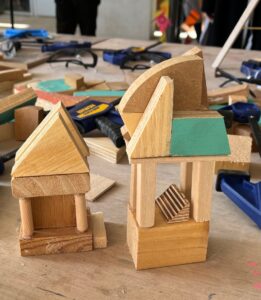Week3&4 Sprint2:Open Toolkits
Toolkits
It was an honour to visit the University of Edinburgh Sculpture Studio in week four, and to be honest, as an undergraduate broadcasting student I have rarely been exposed to similar projects and I was excited.
When I arrived at the studio, I was curious about everything. Under the guidance of our teacher, we were divided into 3 groups and started to complete our first art project – a game about a fantastic story. We needed to set a scene and simulate different instructions based on the props in the scene, so my group and I set up a war setting with colourful little red flags set to different instructions, such as: pink for attack and blue for hold your ground. This was interesting to me because through games like this, we were able to use our imagination to think about the props, and even though the props themselves seemed unconnected, we were able to give them meaning through a story. It reminded me of the ‘conspiracy theories’ we studied in another course: themes in contemporary art – taking unrelated events and making them connected through their causes and consequences. (But they have a different impact.)
To be honest, I found the next two art projects a little difficult. As I am not a very hands-on person, I am grateful to my group members and teacher who patiently guided me and helped me, although there were some hiccups in the process, such as when we were completing the second wooden kit, we couldn’t find the right shape to fit our piece and we finally decided to use a tool to cut it into the shape we needed. I am glad we finished the piece in the end and it looks good.

It was a pleasure to visit the University of Edinburgh Sculpture Studio and I found many interesting things on my way around the studio, such as an artist who documents her artistic imagination by taking photographs and hanging them in her studio, from which I could experience the emotional expression of the creation. The one that struck me most was a photograph of a man who buried himself in a pile of stones with only his feet and hands showing. It seems that the creator wanted to convey through this work that despite the pressures of life ‘burying’ us, we still have to break through the barriers and find ourselves. This expression of emotion may seem depressing, but it gives strength and courage to push through the pressures of life.

Finally, this event has given me a deeper appreciation of art. I used to think of art as a one-dimensional expression, but through my exposure to the studio, I felt the imaginative power of art. A leaf, a photograph, a sculpture work, a handicraft …… It can all be a work of art, and behind these works of art, there is often a certain social connotation, which made me start to think about the social transformation of artworks.On the one hand,for contemporary art in particular, I believe that the concept of contemporary art does not only refer to the creation of contemporary art, but also includes criticism, writing and theoretical writing about contemporary art. The sociological orientation of art theory means that art theory should be refocused on social facts. In other words: we should reinterpret the relationship between art and society, reconceptualise the ways in which artists appear to be individualised and look for the social motivations behind them. On the other hand, from the perspective of the relationship between artists, critics and the public, the sociological transformation of contemporary art will change the notion that artists and critics are regarded as special groups in society. From a sociological perspective, artists and critics are just ordinary people who communicate and interact with the public. I think this is a crucial consideration in my study of contemporary art think this is a crucial reflection in my study of contemporary art.[1]
References:
- Sun Zhenhua, Lu Hong. The sociological turn of contemporary art [J]. Friends of Fine Arts, 2006(01):7.




it was fun to read about your visit to edinburgh sculpture workshop and how you responded to the activities these, this seems like a good way to get to know about different workshops and how people respond to them differently. i like how you mention what you found difficult about aspects of the workshop and how you found solutions to these as a group. its so cool that this event has changed your perceptions so much which shows perfectly the power of making and experiencing together.